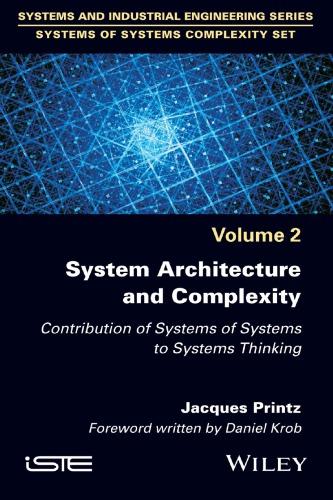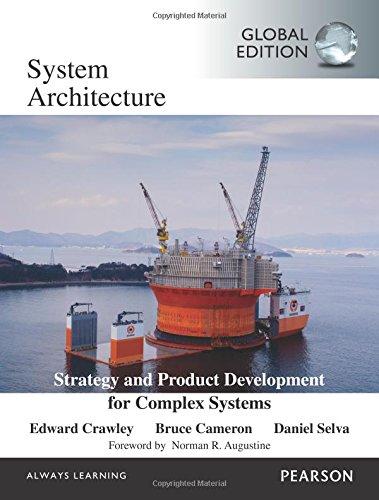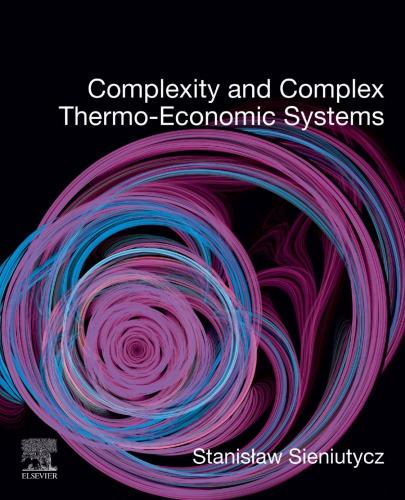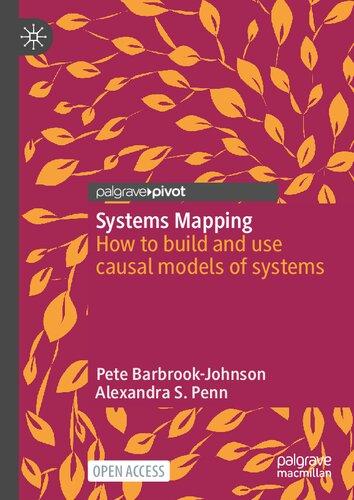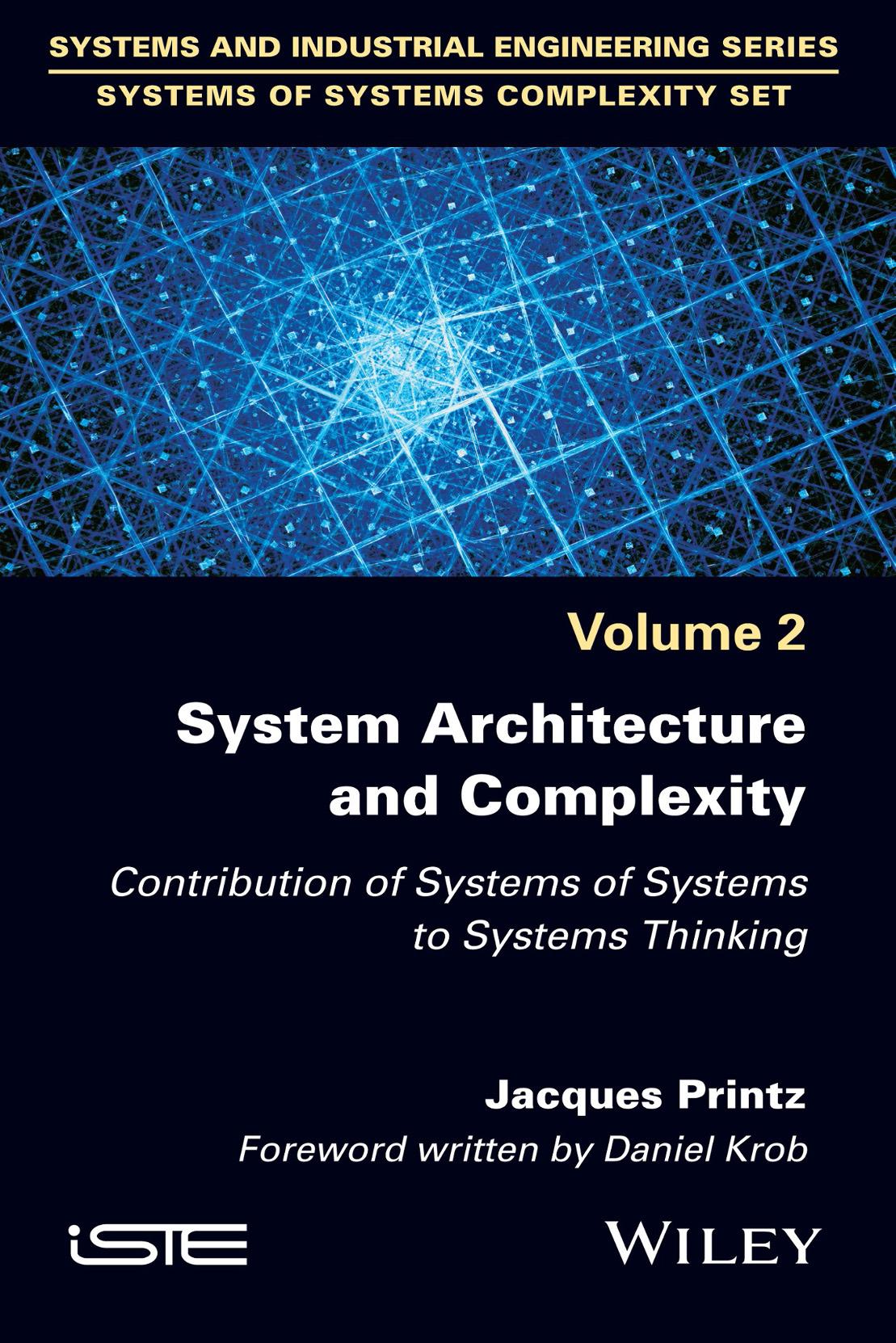Visit to download the full and correct content document: https://ebookmass.com/product/system-architecture-and-complexity-vol-2-contribution -of-systems-of-systems-to-systems-thinking-printz/
More products digital (pdf, epub, mobi) instant download maybe you interests ...
Systems Architecture. Strategy and product development for complex systems Bruce Cameron
https://ebookmass.com/product/systems-architecture-strategy-andproduct-development-for-complex-systems-bruce-cameron/
Complexity and Complex Chemo-Electric Systems Stanislaw Sieniutycz
https://ebookmass.com/product/complexity-and-complex-chemoelectric-systems-stanislaw-sieniutycz/
Complexity and Complex Thermo-Economic Systems Stanislaw Sieniutycz
https://ebookmass.com/product/complexity-and-complex-thermoeconomic-systems-stanislaw-sieniutycz/
Advanced Testing of Systems-of-Systems, Volume 2Practical Aspects 1st Edition Bernard Homes
https://ebookmass.com/product/advanced-testing-of-systems-ofsystems-volume-2-practical-aspects-1st-edition-bernard-homes/
Systems Mapping, How to build and use causal models of systems Pete Barbrook-Johnson
https://ebookmass.com/product/systems-mapping-how-to-build-anduse-causal-models-of-systems-pete-barbrook-johnson/
Architecture of Advanced Numerical Analysis Systems: Designing a Scientific Computing System using OCaml 1st Edition Liang Wang
https://ebookmass.com/product/architecture-of-advanced-numericalanalysis-systems-designing-a-scientific-computing-system-usingocaml-1st-edition-liang-wang/
Architecture of Advanced Numerical Analysis Systems: Designing a Scientific Computing System using OCaml 1st Edition Liang Wang
https://ebookmass.com/product/architecture-of-advanced-numericalanalysis-systems-designing-a-scientific-computing-system-usingocaml-1st-edition-liang-wang-2/
Solutions Architecture: A Modern Approach to Cloud and Digital Systems Delivery Wasim Rajput
https://ebookmass.com/product/solutions-architecture-a-modernapproach-to-cloud-and-digital-systems-delivery-wasim-rajput/
Electrical Systems 2: From Diagnosis to Prognosis
Hubert Razik
https://ebookmass.com/product/electrical-systems-2-fromdiagnosis-to-prognosis-hubert-razik/
System Architecture and Complexity
Systems of Systems Complexity Set coordinated by Jean-Pierre Briffaut
Contribution of Systems of Systems to Systems Thinking
Foreword written by Daniel
Krob
Jacques Printz
First published 2020 in Great Britain and the United States by ISTE Ltd and John Wiley & Sons, Inc.
Apart from any fair dealing for the purposes of research or private study, or criticism or review, as permitted under the Copyright, Designs and Patents Act 1988, this publication may only be reproduced, stored or transmitted, in any form or by any means, with the prior permission in writing of the publishers, or in the case of reprographic reproduction in accordance with the terms and licenses issued by the CLA. Enquiries concerning reproduction outside these terms should be sent to the publishers at the undermentioned address:
ISTE Ltd
John Wiley & Sons, Inc.
27-37 St George’s Road 111 River Street London SW19 4EU Hoboken, NJ 07030 UK USA
www.iste.co.uk
www.wiley.com
© ISTE Ltd 2020
The rights of Jacques Printz to be identified as the author of this work have been asserted by him in accordance with the Copyright, Designs and Patents Act 1988.
Library of Congress Control Number: 2020932472
British Library Cataloguing-in-Publication Data
A CIP record for this book is available from the British Library ISBN 978-1-78630-561-9
3.3.
3.4.
3.4.1.
3.4.2.
5.1.
5.2.
5.2.1.
7.1.
7.2.
7.3.
7.4. Composition
of
Chapter 8. Interoperability
8.1. Means of systemic growth
8.2. Dynamics of the growth of systems
8.2.1. The nature of interactions between systems
8.2.2. Pre-eminence of the interaction
8.3. Limits of the growth of systems
8.3.1.
8.3.3. Limitations of external origin:
8.4. Growth by cooperation ...............................
8.4.1. The individuation stage
8.4.2. The cooperation/integration
8.4.3.
Chapter 9. Fundamental Properties of Systems of Systems
9.1. Semantic
9.2.
9.3. Laws of interoperability: control
9.3.1. Models and metamodels of
9.3.2. Organization “in layers” of the models and
9.3.3. Energy
9.3.4. Systemic
9.4.
Foreword
The systems that mankind structures and constructs are at the very heart of the modern world: in fact, we only need to think of the social and political systems, complex and industrial systems, monetary and financial systems, energy production and distribution systems, transport systems, communication systems and, more generally, the numerous organizational and technological systems that surround us to realize that “engineered” systems1 are simply everywhere…
All these systems are becoming characterized more and more both by a very high level of intrinsic complexity and by ever-increasing interdependences. Mastering these systems has therefore become a real challenge, in a world that is undergoing profound transformation where they must be able to resist the constant and often contradictory pressure of citizens and consumers, markets and regulations, competition and technological innovation, to cite just a few examples of forces that they are subject to2 in almost all fields of industry and services where complex systems play a role (aeronautical, automobile, digital, energy, civil engineering, high tech, naval, railways, mines, spatial, information systems, etc.).
Mastering the complexity of a system fundamentally means being capable of mastering its integration process – in other words, its construction by interconnection and/or connection of smaller systems. This process certainly still remains largely misunderstood insofar as it generates the mysterious phenomenon of emergence: an
1 Living systems are another story and we will limit the scope of our considerations to engineered systems, in other words to artificial systems (as opposed to natural systems) architectured by mankind. This already covers a vast spectrum given that technical systems and organizational systems are both probably going to be included in this conceptual framework.
2 Not forgetting the intrinsic limits of our planet’s physical and environmental resources that are impossible not to take into account.
integrated system will effectively always have new properties – known as “emerging” properties – which cannot easily be obtained or expressed with its basic building blocks.
To thoroughly understand this last concept, let us consider, as a simple example, a wall that is only made of bricks (without mortar to bind them). A simple systemic model of a brick can then be characterized by:
– functional behavior consisting, on the one hand, of providing reaction forces when mechanical forces act on the brick and, on the other hand, of absorbing rays of light;
– internal behavior provided by three invariant states: “length, width and height”.
In the composition of brick models like these, a wall will simply be a network of bricks bound by the mechanical action/reaction forces. But a wall like this can mechanically only have functional behavior consisting of absorbing rays of light. However, it is clearly not the usual behavior of a wall, since the existing holes in the walls (for windows) that must allow light to pass through must be taken into account! We will also observe that it is difficult – and probably in vain – to attempt to express the shape of a wall (which is one of its typical internal states) as a function of the length, the width and the height of bricks that make it up. We are therefore obliged to create a dedicated, more abstract, systemic model, to specifically model a wall when we want to express its real properties. In systemic terms, this is expressed by observing that the wall properties such as “allow light to pass through” or wall characteristics such as its “shape” are properties and emerging characteristics for the wall, meaning that they can only be observed at the scale of the “wall” system and not at the scale of its “brick” sub-systems and that they therefore emerge from the integration process of “brick” sub-systems which lead to the “wall” system. This mechanism of emergence is in fact a universal characteristic of systems: every system always has emerging properties in the way that we have just explained.
These considerations can appear to be logical, or even naive, but unfortunately we can only observe in practice that their consequences are generally not understood, which leads to numerous problems with quality and a lack of control that is observed in numerous modern complex systems. Most engineers and decision-makers effectively continue to think that control of the components of an integrated system is sufficient to control the system overall. However, the very nature of the integration mechanism requires not just directors to be in charge of components when an integrated system needs to be designed: it is also essential to entrust the high level integrative model for the system under consideration to a specific director. This is the key role of a system architect, which unfortunately often does not exist in most industrial organizations, as strange as this may seem for anyone who is conscious of the underlying systemic fundamentals!
Considering the integration of a heterogeneous complex system, the resultant of the interaction of several homogeneous systems, necessarily requires transverse reasoning, constructing models of a new type that capture the emergence by coherently integrating the parts of each homogeneous model that constitutes an overall systemic model. Yet it must be observed that nothing prepares us for this new paradigm of systemic reasoning, which calls for bringing together different expertise of extremely varied nature and to surpass traditional storage of the organization of knowledge, although we have known for a long time3 that we cannot optimize a system as a whole by optimizing each of its sub-systems.
The emergence of a true science of systems – systemics – that is capable of rigorously tackling the numerous problems that are presented by the design and management of the evolution of modern complex systems is therefore an urgent requirement if we want to be able to bring satisfactory answers to the numerous, profoundly systemic challenges that humanity is going to have to respond to at the dawn of the third millenium. This emergence is, of course, not easy because it can easily be understood that the development of systemics is confronted mechanically by the set of classic disciplines that all attempt to provide part of the required explanations for understanding the system and which therefore do not naturally appreciate a new discipline attempting to encapsulate them in a holistic approach.
This book by Jacques Printz is therefore an extremely important contribution to this newly emerged scientific and technical discipline: it is effectively primarily one of the very rare “serious” books published and which provides a good introduction to systemics. It effectively provides an extremely wide view of this field, picking up a lead from system architecture in other words by the part of systemics that is interested in the structure of systems and in their design processes, which allows each and every one of us to understand the issues and the problems related to systemics. We can therefore only encourage the reader to draw from the essence of Jacques Printz’s master book which combines reminders of past development that explain how systemics has emerged, an introduction to the key concepts of systemics, and practical examples that allow the nature and scope of the ideas that are presented to be wholly understood.
However, it will not be possible to easily cover the entire perimeter of systemics because it is too broad a subject. Many other areas could in fact be subjects of other books: system dynamics, system sizing and optimization, system evolution trajectories, the design of homogeneous system families, agile and collaborative approaches for system development, the governance of systems, etc. Readers who
3 This result is due to Richard E. Bellmann in an article on optimal control dating from 1952. He showed that only the systems that can be optimized by parts are linear systems, a class to which no complex system belongs in practice.
wish to know more can, for example, benefit from the series of international conferences “Complex Systems Design & Management” that the CESAMES association organizes each year in Paris and every two years in Asia4 and which allow the vital signs of the systemic approach applied to engineering of complex systems to be regularly taken. The numerous conferences organized by the international organization for systems engineering, INCOSE (International Council on Systems Engineering), are also excellent places for more information about this field, and meet the international community that is interested in these problems.
The universe of systems is in fact a “continent”5 that creates a true scientific and technical field for a real science of systems. However, systemics still remains to be constructed, necessarily in a profound interaction between theory and practice, despite the awarness of great pionneers such as H. Simon and K.L. von Bertalanffy. Unfortunately, there have not been many who have followed in their footsteps. Let us hope therefore that the systemic challenges that the modern world has begun to tackle are at last going to allow this to emerge.
Daniel KROB Chairman
CESAMES (Centre d’excellence sur l’architecture, le management et l’économie des systèmes – French Center of Excellence for Architecture, Management and Economics of Systems, http://cesam.community/en/)
Paris and Professor École Polytechnique
Paris and INCOSE Fellow
4 The conference “Complex Systems Design & Management Asia” was organized from 2014 to 2018 in Singapore. The 2020 edition of this conference is being organized in Beijing with the support of the Chinese division of INCOSE and of the Chinese Aeronautical Federation. 5 Using an expression that Marcel Paul Schützenberger would probably not have denied.
Preface
This book has a long history!
Over the course of our respective experience, we were convinced of the requirement to allocate importance to teaching a new genre that has accompanied the development of IT, and IT systems, since their creation. The milestones of this evolution can be summarized in a few titles: Industrials Dynamics and Principles of Systems by J. Forrester, Sciences of the Artificial by H. Simon, and the series by G. Weinberg, Quality Software Management, Volume 1: Systems Thinking (or even its Introduction to General Systems Thinking), accompanied by three other volumes. Perhaps also the three volumes by J. Martin, Information Engineering
In the 1990s, there was a major event whose overwhelming effect on our system of thinking has perhaps never been measured completely: IT definitively ceases to be included as a centralized system around a “large” mainframe controller, to become a distributed system, an assembly of “clients” and “servers” that provide mutual services to each other and that must, however, be integrated. There is no “center” in the vulgar meaning of the term, or rather, the center is everywhere; everything interacts. Machines that will soon be hand-held are infiltrating and infusing into society as a whole, in all fields. The challenge is expressed in two words: parallelism and integration, notwithstanding a quality of service connected to the diffusion of technology and the risk associated with use.
In this context, under the instigation of C. Rochet, who was in charge of a training program for these new systems at the IGPDE1, the idea of proposing a complete training cycle that gave great importance to this system thinking was born,
1 Institut de la gestion publique et du développement durable (French institute for public management and economic development); permanent training operator of the Ministry for the Economy and Finances and of the Ministry for Action and Public Accounts.
in association with the École Polytechnique and via the chair of Complex Systems Engineering directed by Daniel Krob, with useful contributions from the CNAM. A process of the same nature was developed at the Ministry of Defense via the DGA (Direction générale de l’armement – French Directorate General of Armaments).
An original training program was created from this intense activity, indissociably combining an essential conceptual contribution and an immediate implementation of newly acquired concepts, all of which led to the training in systems architecture that is currently provided by CESAMES Academy, a course with the RNCP2 label.
This book is the result of this past history and countless discussions, reports, presentations, conferences, tests/errors, etc. that have accompanied it. Since the observation drawn from the available literature in French, either the available works were obsolete – dating from before the distribution revolution – or incomplete and/or ill-suited because they were too qualitative and not integrated into a project framework that would allow coordinated action between all the parties involved and the engineering teams, which are themselves distributed.
To create systems that respond to the present and future requirements of the users, we first need to “think” about complexity in a context that is precisely that proposed in this book, hence its title and subtitle.
Jacques PRINTZ February 2020
2 Répertoire national des certifications professionnelles – French national register of professional certifications, see http://www.rncp.cncp.gouv.fr/.
The Legacy of Norbert Wiener and the Birth of Cybernetics
Without intending to be an exhaustive historical account, this chapter provides some specific details regarding the concerns of the founders of what is now the science of systems or systemics, in order to understand the stakes that still remain extremely relevant today. Its objective is to avoid the anachronisms that are often the origins of serious misinterpretations.
In this chapter, we propose to revisit the key event system sciences, or systemics originated, in which the mathematician N. Wiener, professor at MIT, has been an emblematic actor1. The summary that we propose does not claim to provide a chronological history of the facts as far as it could be restituted2, which would in any case not be of great interest. It attempts, on the other hand, to recreate the dramatic climate of the era in which all available researchers find themselves caught up in the efforts of the Anglo-American war to fight against totalitarian regimes. Some do so with conviction and without scruples, such as J. von Neumann, others due to a moral duty, such as N. Wiener who was a pacifist and felt disgusted by violence. This is a period of intense interactions and exchanges between exceptional scientific personalities, often of European origin, where urgent action against totalitarian regimes is the common good. To make sense of this situation, it is necessary to
1 But not the only actor! J. von Neumann played a major role, if not more important, on the practical and theoretical plans. For a complete overview, refer to G. Dyson, Turing’s Cathedral – The Origins of the Digital Universe, Penguin, 2012; W. Aspray, John von Neumann and the Origins of Modern Computing, MIT Press, 1990, in particular Chapter 8, “A theory of information processing”.
2 One of the essential works that best describes this very particular atmosphere is the work by S.J. Heims, John von Neumann and Norbert Wiener, From Mathematics to the Technologies of Life and Death, MIT Press, 1980; and more recently, P. Kennedy, Le grand tournant: pourquoi les alliés ont gagné la guerre, 1943–45, Perrin, 2012.
imagine trying to put ourselves in the situation in order to judge the potential importance of the contributions made by each one, and to do this, it is essential to have a thorough understanding of the problem.
REMARK.– We have voluntarily ignored the contribution made by the biologist L. von Bertalanffy and his General System Theory, which today is only of historical interest3. Its influence in the field of engineering has been small, even zero, given the level of generality in which it was situated, and in any case, engineering was not his field of concern, contrary to N. Wiener, C. Shannon, J. von Neumann or A. Turing who “got their hands dirty” with machines and/or real systems.
1.1. The birth of systemics: the facts
The problem presented to N. Wiener4 and his group at the MIT5 was to study methods to increase the number of shots hitting the target and improve anti-aircraft defense, whose effectiveness could be measured by the ratio of the number of shots fired per downed airplane. Its overall objective was to improve the management of “shell” resources, inflict the greatest damage to the enemy (airplane pilots are a rare resource) and above all to save human lives.
At the time, when N. Wiener began his reflection, a summary of the technological environment would read as follows:
Gunners had perfect knowledge of ballistics and used firing charts to make adjustments to land-based cannons, for straight shots and for parabolic shots, over distances up to 20–30 km (correction required for the Coriolis force that is caused by the rotation of the Earth). The final targeting was carried out by observers close to the points of impact, who gave correction orders by telephone in 1914 and then by radio in 1939–1940. Shots were fired by the DCA (air defence) in a completely new environment onto moving targets – airplanes with speeds of up to 600 km/h, in other words, approximately 170 m/sec, at altitudes of 5–6,000 m. With shells of high initial speed, 800–1,000 m/sec, 5–6 seconds passed before the explosion capable of destroying the target was triggered, without taking into account the deceleration that slows down the initial speed.
3 For an exhaustive study, refer to the thesis by D. Pouvreau, Une histoire de la “systémologie générale” de Ludwig Bertalanffy – Généalogie, genèse, actualisation et postérité d’un projet herméneutique, EHESS, March 2013.
4 Refer to Chapter 12, “The war years 1940–1945”, from his autobiography, I Am a Mathematician, MIT Press, 1964.
5 Among others J. Bigelow; refer to article “Behavior, purpose and teleology”, cowritten by A. Rosenblueth, N. Wiener, J. Bigelow, which can be downloaded from the JSTOR website.
REMARK.– In 10 seconds of freefall, a weighted object travels approximately 500 m and reaches a speed of 100 m/sec (360 km/h).
Combined with the speed of the airplane and with the initiatives taken by the pilot who can change course, we can easily understand that the “shot hitting the target” is something highly improbable. It is also the reason why it is necessary to “spray” a very wide area, with many cannons and a great quantity of munitions, to have a hope of making an impact; it is best to forget about efficiency.
The first radar (radio detection and ranging) equipment made their first appearance in England where they played an essential role and allowed the RAF to contain the attacks by the Luftwaffe. The radar allowed regrouping bomber formations to be “seen” far in advance, something that no observer would be able to detect simply by visual means, given the distances, with in situ information an impossibility. Thanks to radar, the command center for aerial operations understands what is probably going to happen and can therefore position its retaliation in advance with maximum efficiency for “attack” airplanes. In other words, radar provides all information about the trajectory followed by the target: position, speed and possible acceleration, and integrates all that to calculate the probable trajectories of bombers.
MIT (Massachusetts Institute of Technology) had, at the time, one of the very first electronics laboratories for the study of servomechanisms – the Lincoln Laboratory. It later proved its worth in the construction of the SAGE system6, the first anti-aircraft defense system that can be described as modern. Servomechanisms are becoming essential devices for automatic adjustment of mobile mechanical parts in such a way as to control their movements as minutely as possible and absorb the shocks that generate destructive vibrations. This is fundamental to move the chassis of anti-aircraft guns and follow the trajectory of target airplanes. Servo-control of the movement requires precise measurements, in particular of the mass to be moved, in order to activate effectors with the right adjustment data and make cyclic corrections.
These developing automatisms led to all studies concerned with the transfer functions that have the fundamental properties of reincorporating as inputs some of the results that they produce as outputs. Knowledge of the function of transfer, obtained either empirically by experimentation; theoretically by calculation, or by combination of both of these, is therefore fundamental data for correct control of the mechanisms in question.
6 Semi Automatic Ground Environment; refer to the book by K.C. Redmond, From Whirlwind to MITRE: The R&D Story of The SAGE Air Defense Computer, MIT Press.
Using these mechanisms, amplification will be possible in a ratio of 1:100, 1:1000 or much more, depending on the principle of the control stick or of the rudder. They use a low energy signal (electric current, shearing a hydraulic circuit) which at a smaller scale closely reproduces a phenomenon of much greater energy, such as the movement of a gun carriage that may weigh several hundreds of kilos, or even a few metric tons for the turrets of marine artillery for which compensation of the erratic movements of the boat must be made. Obtaining “true” signals that are uncontaminated by random “noises” from the environment is therefore absolutely essential.
We also know how to “calculate” some of the fundamental mathematical operations of differential and integral calculus, in a rapid and unexpected manner. This is by using analogical calculators that are quite difficult to manipulate, such as those that equip the gunsights of B29 bombers – another celebrated airplane among those used during World War II. The first computers arrived a few years later, but it is certain that N. Wiener already had relatively precise intuition given the exceptional environment that he was surrounded by and to which he was one of the star contributors. He knew J. von Neumann well and had held discussions with him on many occasions7.
Rather than making long and fastidious calculations by hand, consulting tables and charts that are familiar to engineers, it was becoming simpler to carry out calculations directly with “programmed” functions in analogical form. And since in addition, we knew how to “clean” the signal that carried information about the background noise, it was possible to calculate the adjustment parameters required for the various appliances, on demand.
1.1.1. The idea of integration
N. Wiener’s stroke of genius is to have understood that by integrating all these technologies appropriately and by managing to ensure all those working on their development worked together, we would be able to create machines capable of imitating behaviors such as the gesture of a baseball player. A popular sport among students at Ivy League universities on the East Coast, baseball requires precisely intercepting balls arriving with strange trajectories (“curveballs”), thrown by the “pitcher”.
In a certain way, we can say that the machine has, in the memory of its electronic circuits, a “model” of the behavior of objects on which it is supposed to act, to be precise the airplane/pilot couple. The dedicated term to designate this type of
7 Refer to John von Neumann: Selected letters, History of mathematics, vol. 27, London Mathematical Society, American Mathematical Society, Miklos Rédei.
The Legacy of Norbert Wiener and the Birth of Cybernetics 9
capacity, that only appeared with the first IT applications 30 years later, is “metamodel”, because the rules that define it are independent of the medium. They are beyond, or above (the meaning of the Greek word μετα) the material format. Since programming is itself a model, the model of this programming is described as a metamodel to avoid confusion; it is a logical entity that is capable of instructing itself with its own rules, such as the universal Turing machine that can instruct itself or the grammar of written French which in this case is its own metalanguage. When computers began their exponential development, in the 1970s–1980s, we quickly understood that these fundamental rules to understand systems can, and even must, be specified in a language that is independent from the various possible targets. It can be expressed in the language of the universal Turing machine, independent of all technology8, therefore adaptable to all physical formats that allow their logic to be expressed in a way that can be represented (analogue circuitry, electronic tubes and soon transistors). This is a pure abstraction, totally immaterial, but without which it is impossible to act. The model obtained in this way concentrates the information required for action of the system (what it does, in operational terms) and for action on the system (how it is done) in its physical reality; it defines the means of valid interactions, and to this end, it operates as a grammar of the actions to be carried out.
REMARK.– We note that any abstraction level in a system is a model of the entities that are thus abstracted. In a modern computer, there are easily 20 of them! Rather than piling up the “meta”, it is more simple and clearer to say that layer N has a model of the layer that is immediately lower in the hierarchy of system entities, which allows us to program services on this same layer using only the interface defined by the model.
Now we turn to 1942–1943, when already one of the first laws of new systemics could be formulated:
To interact with an environment, any system must have an abstract model of this environment, meaning of the information, independently of the physical/organic nature of this environment and of the system (law no. 2 of the compendium, section C.2.2).
In the case of the firing system studied by N. Wiener, the model comprises rational mechanical equations, Lagrange/Hamilton version, applied to the ballistics of atmospheric trajectories whose parameters must be known: temperature, pressure, humidity, winds, etc.
8 In theoretical computer science, the Church–Turing thesis states that everything that is “calculable”, in the logical sense of the word, can be expressed by a Turing machine which becomes, due to this, a universal modeling language; this is the case today where computer science has diffused into all disciplines.
Machines designed on these principles – imitating certain behaviors that are until then characteristic of living organisms – were thus attributed with an entirely mechanical “intelligence”. Later, in the 1950s, it was known as “artificial intelligence”9, completely constructed by human intelligence, thanks to knowledge of the laws of nature and the capacity for rapid and precise retroactions, for secondor third-order corrections (these are infinitesimal quantities), meaning the magnitude at instant t, its first and second derivatives. More prudent, Norbert Wiener used the term “machine learning”, as early as 1946, less misleading and more precise than the media-friendly “artificial intelligence”, to create dreams! A term that is still used in the United States, in preference to artificial intelligence.
In fact, the airplane trajectory is not random because it is subject to different types of determinisms that the pilot must take account of in their decisions, knowing that they can be impossible to predict, although probable. The airplane is subject to the laws of rational mechanics and to the laws that mechanics of its structures that can break, the strength of materials being one of the pillars of engineering sciences. The pilot can also execute dangerous, even mortal, maneuvers, for their own physiological safety (“black” sheet, increase of the apparent weight and difficulty in moving, loss of consciousness due to the centrifugal force, etc.), and it must take into account the decisions of other pilots in their squadron. Despite all these constraints, the trajectory can be extrapolated and calculated thanks to the data collected by radars. N. Wiener was a master of calculation of apparently random trajectories, such as those particles subject to Brownian motion, that he was the first to know how to calculate, using Lebesgue integrals of which this was one of the first concrete applications. He considered statistical mechanics, and its creators J.C. Maxwell, L. Boltzmann and J. Willard Gibbs, as an absolutely essential contribution to the new physics that was taking shape, and as a more correct understanding of the, operation of nature and of its representation.
REMARK.– Let us remember that for a curveball, at least four points are required. With a single point, we are in “a ball”, two points determine a direction (the speed). With three we have the plane acceleration (curvature) and with four we have two planes and therefore the torsion of the curve – in other words a position and three vectors. With these four parameters, the movement can be located in a narrower and narrower cone.
This data can be the basis for calculation of the exact values, to provide to servomechanisms to point the guns in the right direction, follow the movement of airplanes and adjust the shell rockets so that they explode at the right moment, in the most probable region of the presence of airplanes. All of this takes place while
9 Term used by J. Mc Carty, in 1955–1957, then at Dartmouth, with a preference for the austere Mathematical logic
correcting the margin with the latest data coming from the radars, as long as calculations are made fast enough and data is transfered without error10. Effectively, between the instant T of the situation, and the instant where the orders transmitted will be effective, there is a time difference ΔT; if ΔT is too big, given the evolution of the situation, the orders will not be adapted. This interval ΔT, response time and/or latency of phenomena, is a fundamental information regarding the transfer function.
N. Wiener very quickly understood that here he had at hand all the ingredients for a new method of analysis of the problems, allowing new solutions to situations that had remained inaccessible to analysis because they were too complex – far beyond “simple” machines that engineers had dealt with until then. And with a correct interaction of what is “simple”, we could create something “complex” that is controlled, useful and organized, which respects the laws of engineering. His own way of creating order in a world that is subject to undifferentiated disorder.
He christened this “new science” cybernetics, or the art of steering, in the same way as a helmsman, by adapting the Greek word (κυβερνητική) used to designate the pilot of ships with which the ancient Greeks had conquered the Mediterranean –an unstable sea if ever there was one – and a term that is found in the roots of many words such as government, to govern, etc.
The very essence of this new science pertains to time-related actions that are carried out in an unstable environment – to go from a point A to a point B in a nonlinear fashion, exactly like a helmsman who knows that a straight line is never the right way to go about setting a course when currents, tides, winds, the movement of the boat (rolling, pitch, yaw), waves, etc. need to be taken into account to maneuver the sails and the rudder. The actions carried out are finalized11, meaning organized and controlled as a function of the objective to be reached, the goal, and this is the new fundamental point, which is a moving target resulting from an environment that is itself structured but whose laws are largely unknown, although they do exist (much later, deterministic chaos was used to characterize them). It must therefore be possible to continuously adapt the action plan, which is difficult with analog calculators, but which is intrinsic to the architecture of von Neumann where the information recorded in the computer memory (computing instrument in his terminology) is sometimes
10 In his book dated 1951, Reliable Organisms From Unreliable Components, von Neumann wrote: “Error is viewed, therefore, not as an extraneous and misdirected or misdirecting accident, but as an essential part of the process.” Also refer to Chapter 15, “Theory of self-reproducing automata”, in the book by G. Dyson, Turing’s Cathedral, already cited, which is essential regarding the central role played by the errors in the engineering process. 11 Before the very official Macy Conferences, from 1942 to 1953, there had been an ephemeral Teleological Society which met informally; refer to S.J. Heims, The Cybernetics Group, MIT Press. In French, refer to the book by J.-P. Dupuy, Aux origines des sciences cognitives, which gives a good overview of this, but from a point of view that is subject to discussion, interesting in the same way as everything else he has done and written.
program and sometimes data (but another 10 years were required before this logic dream became reality). How can the environment be put to good use to reach the objectives: this is the ambition of cybernetics. To do this, it will be necessary to be “intelligent”, in N. Wiener’s meaning of the term, meaning as a mathematician12.
Taking time to think about it, we see that we are dealing with a double trajectory13, a double dynamic. On the one hand, the aspect imposed by the environment (meaning what is considered as not part of the system), what biologists like C. Waddington named “epigenetic landscape” (that René Thom rechristened substrate space or even phenomenological deployment) and on the other hand, the mobile aspect that the pilot can direct taking into account the intrinsic properties of this mobility and the experience that it has of the behaviors observed in the environment and of the evolving dynamic that characterizes it. The steering therefore consists of servo-controlling the trajectory to go from A to B, using the environmental dynamics to advantage in order to optimize the journey. When the pilot has navigated sufficiently and acquired experience – either empirically or theoretically through knowledge of the phenomenological laws that structure transformations of the environment that they are also part of – they know how to put the actions together that will allow them to reach their goal, scheduling that they alone can judge because they know the local situation.
The pilot must therefore extract information from their environment and to do this, they must have suitable sensors, and translate this information in the behavioral “language” of the effectors of the mobile that the designer is master of, an operation that physicists and electronic engineers are very familiar with, for which the dedicated term is “transduction”, for example transform an electric current into hydraulic pressure servo-controlled on the signal conveyed by the current (see Chapter 6).
In N. Wiener’s approach, anyone who uses the term interactions, implicitly means elements that interact in a certain order via energy exchanges. These elements are the constituents of the system (the buildings blocks in today’s computer science jargon; a much better term than that of “black box” often used at the time), to the exclusion of others that are therefore simply ignored, but which exist all the same.
For N elements, there are N×(N-1) monodirectional exchange links, but if the system organizes itself, if certain elements have a “memory” (possibly from layered human operators), it will be necessary to consider all the parts of these elements. Either through theoretically 2N combinations or sequences of temporal actions that are possible in an even greater number, sequences that will be investigated thanks to
12 Refer to his autobiography, I Am a Mathematician, MIT Press, 1956, which leaves no doubt about the way we see the world.
13 In geometry, these are graphs known as tracers; refer to https://en.wikipedia.org/ wiki/Tractrix.
the theory of automatons for which J. von Neumann provided the basis at a later date14. The beginnings of the theory or theories of complexity therefore took root right at the start of the science of systems, but it was J. von Neumann who was the true initiator15. Curiously, N. Wiener never talks about this, nor does he talk about the theory of automatons, which does not mean that he did not know it16! Organizing this complexity, meaning specifying the architecture of the system using rigorous and precise logicomathematical models, quickly became the organizing center of projects, such as the SAGE system, with J. Forrester who carried out the first living demonstration of this in the 1950s.
He was the first to become fully aware of the practical problems of interdisciplinarity and attempted to resolve them, thanks to models that allow exchanges between the concerned parties, including military personnel in the case of SAGE17.
Concerning the very object of cybernetics, N. Wiener’s point of view cannot be clearer. He tells us18:
“From the point of view of cybernetics, the world is an organism, neither so tightly joined that it cannot be changed in some aspects without losing all of its identity in all aspects nor so loosely jointed that any one thing can happen as readily as any other thing. It is a world which lacks both the rigidity of the Newtonian model of physics and the detail-less flexibility of a state of maximum entropy or heat death, in which nothing really new can happen. It is a world of Process, neither one of a final equilibrium to which Process leads nor one determined in advance of all happenings, by a pre-established harmony such as that of Leibniz… Life is the continual interplay between the individual and his environment, rather than a way of existing under the form of eternity.”
14 Concerning this very fundamental subject, we can re-read the memo written by C. Shannon, Von Neumann’s Contributions to Automata Theory (readily available on the Internet); also refer to the recent book by G. Dyson, Turing’s Cathedral – The Origins of the Digital Universe, already cited.
15 Refer to the retranscriptions of his conferences at the Hixon symposium, September 1948, on Theory of Self-reproducing Automata, University of Illinois Press, 1966, published posthumously by A.W. Burks; and volume V of the complete works: Design of Computers, Theory of Automata and Numerical Analysis, Pergamon Press, 1961. This is irrevocable for anyone who wants to take the trouble to read, then. S. Ulam developed certain ideas provided by his colleague and friend about self-reproducing automatons.
16 He certainly uses the term “automaton”, but not in the rigorous mathematical sense that von Neumann gave it in his various writings.
17 On all these aspects, refer to K. Redmond, T. Smith, From Whirlwind to MITRE, The R&D story of the SAGE Air Defense computer, MIT Press, 2000, already cited.
18 Autobiographie, p. 327.
This is indeed about the science of systems, with no doubt, even though we could detail his words further.
1.1.2. Implementation and the first applications
Cybernetics has had a strange fate on each side of the Atlantic.
In the United States, it has remained grosso modo an engineering science where it has prospered under the auspices of the MIT, with in particular J. Forrester, SAGE project director and future professor at the Sloan School. He published, among others, two books that marked important milestones in systems sciences: Industrial Dynamics, in 1961 and Principles of Systems, in 1971, recently republished by Pegasus Communications. Cybernetics by N. Wiener, (Forrester version), has been successfully included in the engineering cycles of complex systems, sometimes without even being mentioned by name, a true implementation of the “wou wei”, the art of governing without action, without effort and spontaneously, of the emperors of China19, particularly in engineering of quality20 which is fundamentally an integrated control throughout the system lifecycle in compliance with the service contract requested by the system users. Quality is a “trajectory”, a pathway, which is constructed by taking into account the hazards of the project environment, including those of organizations. For this, it must be kept in mind by all the actors and concerned parties, and not in a quality sense that is exhibited like a dancer to demonstrate that it is being done. The vocation of quality is to be, not to only seem, prominent and not salient, which acts like a force field. The entropic nature of human activity means that if it is not maintained over time, it degenerates and the undifferentiated disorder takes over again.
Recently, systemics has even undergone a true media success in the United States with a cult book, The Fifth Discipline, which presents System Thinking for a wide-ranging public, in the simple language that English-speakers enjoy so much21.
19 In the Forbidden City in Beijing, in the meeting room of the Palace of Tranquil Longevity, all visitors can see the two characters “wou wei” written in traditional Chinese above the throne of the Emperor: 無 爲
20 Refer to the works of G. Weinberg, in particular Quality Software Management, System Thinking, Dorset House Publishing, 1991.
21 The Fifth Discipline: The Art and Practice of the Learning Organization (first edition 1990, latest edition 2006); book by Peter Senge, professor at MIT. P. Senge explains in this book the integrator role of System Thinking in what is known as Core Disciplines: Personal mastery, Mental Models, Building Shared Vision, Team Learning which are also great classics in the field of quality management and project management.
In France, things have been different because very quickly cybernetics sought fields of application that went far beyond what they were capable of explaining, owing to a lack of prediction, in sociology of organizations or in biology22. Norbert Wiener himself probably contributed indirectly to this state of affairs under the influence of his book destined for the wider public The Human Use of Human Beings, which was very quickly released in French under the simple title Cybernétique et société23 (meaning “Cybernetics and Society”). This a more accessible book than his Cybernetics: or Control and Communication in the Animal and the Machine, which appeared simultaneously in 1948 from MIT Press and Hermann in France. In the rest of this volume, we will denote that book by the shorthand C/CCAM.
Unavailable for a long time in French, this seminal book was translated by Éditions du Seuil, in 2014, in the Sources du savoir collection, with a presentation of the context by the science historian Ronan Le Roux, based on his PhD thesis work, La cybernétique en France (1948–1970) (cybernetics in France), defended in 201024. The French title is: La cybernétique –information et régulation dans le vivant et la machine (meaning: Cybernetics – Information and regulation in living beings and machines). We note that control has been rendered by control, which is perfectly correct, but that communication and animal have respectively been rendered by information and living, two translations that we can contest. As Wiener himself says, “Traduttore, traditore” (C/CCAM, Chapter VIII, “Information, language, and society”).
In the introduction to their book The Mathematical Theory of Communication, Shannon and Weaver are, however, particularly clear. They tell us, in the introduction: “The fundamental problem of communication is the reproduction, either exactly or approximately at one point, of a message that was selected at another point. Frequently the messages have meaning; […] These semantic aspects of communication are irrelevant to the engineering problem.” In communication, we are only interested in the structure, in the syntax and the coding, and of course in the mistakes. The distinction between communication and information is therefore very radical. When we talk about ICT, we note the same distinction; in academic disciplinary fields, we distinguish sciences and technologies of information and communication (STIC) from other fields, while maintaining the distinction between information and communication. Mathematics, in the sense that it constitutes the “language of nature”, is part of the STIC, but mathematicians would certainly be offended if we said to them that their science came from cybernetics, irrelevant they would say! Look at the short text by Grothendieck, found below. This choice of translation is therefore not the most judicious, at the least, because it maintains a confusion, which means that the proposed translation is at the limit of a false meaning. “Information” is much wider than “communication”, and includes sciences of language, natural and/or artificial, including
22 We can re-read the remarkable recension of this work produced by L. de Broglie in no. 7 of the NRF review, July 1953, Sens philosophique et portée pratique de la cybernétique, unfortunately too quickly forgotten.
23 Several editions, including the most comprehensive by UGE/10-18 in 1971.
24 Available from Garnier under the title Une histoire de la cybernétique en France, 2018.
mathematics. The information is intentional by nature, performative as linguists say, because it conveys meaning, which is something that the communication according to Shannon refuses to do, and which, just like the laws of physics, needs to remain objective. The same can be said for the term “living”. Animals are unequivocally elements of the living, in general; with viruses, the frontier with chemistry is perhaps more blurred? Animals are living organisms that are born and die; their main objective is to survive, because as P. Kourilsky states in his book Le jeu du hasard et de la complexité, “to live, you firstly need to survive”. To survive, eat, reproduce, animals have projects, they develop strategies, with intermediate objectives, and a final goal. Where there is no purpose, there is no control, because in order to control it is necessary to know with respect to what we are controlling; this is perfectly clear in C/CCAM, as well as in the article “Behavior, purpose and teleology”, previously cited. Why has this choice of translation been made? Is it the very notion of teleology that bothers translators of the book? We know that the “politically incorrect” term purpose/teleology is banned from biological speech, let us say since the book by Jacques Monod, Le hasard et la nécessité (Chance and Necessity), replaced by “chance” which in this case does things very well. This is a little strange in engineering sciences, because what is more teleological than engineering? Even though we use the term “project” because it is indeed teleology that we are talking about. The entire quality approach, up to the most recent developments, like lean management, is teleological in its very essence. Project management is a perfect example of application of cybernetics to an engineering organization as is practiced in systems engineering. Norbert Wiener was a professor in one of the most prestigious engineering institutions and he trained engineers (see section 1.3). Manufacturing machines or systems presumes that there is an objective to be reached, an objective that will materialize in a construction plan, with the detail of the parts and of the assembly method, without which integration is impossible when the number of parts exceeds a few dozen. With 100 parts, there is a factor 100 (noted 100!) combinations, in other words approximately ≅ 9.3 × 10157; given that there are only 1080 atoms of hydrogen in the observable universe, do we understand that without a plan, chance will not operate?! In an engineering project, the importance attributed to chance must be zero; this is what we call risk management, a risk that must be compensated for by suitable counter-measures for the engineering to be sound.
I have not gone through the entire translation with a fine comb, but we can all the same remark that in the introduction to the 1948 version, the article by Rosenblueth, Wiener and Bigelow, above, appears as a footnote, whereas the note disappears in the translation (done on the 2nd edition in 1961 with MIT Press, whom I have not consulted). To be perfectly honest, R. Le Roux does mention this article in his presentation, and gives a brief summary of it.
These few reservations aside, we acknowledge this translation; but as always, it is necessary to consult the sources themselves, which nothing can replace.
Box 1.1. The translation of Cybernetics by N. Wiener
Thanks to cybernetics, N. Wiener intended to explain the complexity of human societies, history, which in positivistic minds like A. Comte awakened old memories of the social “engineering” and “physics” of which É. Durkheim positioned himself as a master in his founding works. In the atmosphere of the 1950s, in the middle of the Cold War that may have turned hot at any moment, some dreamed of “machines to govern the world” managed by “scientists”, considered more reliable than the politicians and ideologists that had plunged the world into chaos. Utopic dream, of course, because since von Neumann had restated, a short time before his death by interrogating: “Who is guarding the guardians?” This is the entire problem, centralized and/or distributed, you must choose, and interact, avoiding both gulags and re-education camps for “new humanity”, and the individualistic disorders of “every man for himself”.
It is still the case that cybernetics never really entered the territory of engineering sciences, except at the edges, thanks to individual initiatives25, with a small exception in the CNAM syllabus, where the action of professors J. Lesourne26 and J.-P. Meinadier27 must be shown; in any case not in the large engineering school programs, where it had a reputation as rather scandalous and not serious. It is true that when we examine the jargon introduced by Edgar Morin in a cold light and without searching for controversy, we have a sickening feeling due to the excessive inflation of verbs and the combination of hollow words that flow freely28 “Nebulous” our teachers would have said! Creating neologisms each time that we believe we have discovered something original has never explained anything, nor resolved the smallest problem. We have known this ever since G. d’Ockham and his principle of sobriety, at least!
Without injury to the past, and reconstructing a plausible situation, perhaps in the mindset of N. Wiener, this was a way of providing retort to J. von Neumann who had just released his very famous Theory of Games and Economic Behavior that was going to revolutionize economic sciences – except that he did not have the mathematical language that would have allowed him to express his ideas that were forming in all directions. For anyone who has read in detail his latest works, in particular God & Golem, Inc. published in 1964, the year of his death, it is very
25 Such as the one by G. Donnadieu at the IAE; refer to his book, written with M. Karski, La systémique, Penser et agir dans la complexité, 2002.
26 His book, Les systèmes du destin, Dalloz, 1976, and a few others, have been a basis for his lessons in forecasting.
27 His two books, Ingénierie et intégration des systèmes, 1998, and Le métier d’intégration de systèmes, 2002, both with Hermès, remain essential reference works.
28 This remark only relates to the part of his book that concerns La méthode and similar texts; his sociology analyses are generally interesting. Refer to the point of view expressed by J.-P. Dupuy in Ordres et désordres, Chapter 7, “La simplicité de la complexité”, that I share.
clear. He said to us (p. 88): “cybernetics is nothing if not mathematical”, and a little further: “I have found mathematical sociology and mathematical economics or econometrics suffering under a misapprehension of what the proper use of mathematics is in social sciences and of what is to be expected from mathematical techniques, and I have deliberately refrained from giving advice that, as I was convinced, would of course lead to a flood of superficial and ill-considered work.”
In addition, he was quite critical of J. von Neumann’s game theory because he considered that it was impossible to assimilate the economy to an immobile game, in a world where everything changes, including the rules of the game, which is obvious; unfortunately, J. von Neumann, who died in 1957, was no longer there to provide an answer. No doubt that N. Wiener would have had a strong reaction to jargon and the conceptual clutter that inundated his theory, and made cybernetics inoperable, at least for engineers, – he who had been a professor at one of the most prestigious universities in the world, his beloved MIT. Concerning “financial mathematics”, an oxymoron, and the “systemic crisis” that we have been going through since 2008, he would very probably choke with anger “Ill-considered work!”
Now this language that is required for a good description of the processes that are at work in systems, came about in the 1950s–1960s. Today we are well aware of this: this is the language of computer science, and more particularly languages such as IDEF, UML/SysML and BPML/BPMN29.
R. Thom who was very strongly opposed in his typically undiplomatic fashion to the “dictatorship of fuzzy concepts”30 had attempted to answer this with his catastrophe theory, a name introduced by his English colleague C. Zeeman. He did not claim to have instigated himself, but even this was not a great success, for the totally opposite reason that a high level of mathematics was required to understand his geometric language, involving differential manifolds and singularities. One of his best commentators, the great Russian mathematician V. Arnold31, said that between two lines of Thom, 99 more lines were needed to create something that was at least comprehensible! His work Stabilité structurelle et morphogenèse (1972) could therefore have rivalled the thousands of pages of the seminar on algebraic geometry given by his colleague at the IHES, A. Grothendieck. Communication was decidedly difficult!
29 Refer to https://en.wikipedia.org/wiki/IDEF; https://en.wikipedia.org/wiki/Systems_Modeling_ Language; in addition to https://en.wikipedia.org/wiki/Business_Process_Modeling_Language.
30 Refer to his article published in Les Débats, “Halte au hasard, silence au bruit”, 1980.
31 Refer to his book Catastrophe Theory, 3rd edition, Springer, 1992.
